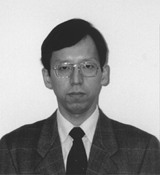

|
Akito SakuraiNovel Functions Hitachi Laboratory |
| Profile | |
| Affiliation: | Advanced Research Laboratory, Hitachi, Ltd. |
| Birth date: | April 16, 1952 |
| Birthplace: | Shizuoka Prefecture |
| Background: | |
| 1975 | Graduated from the Department of Mathematical Engineering and Instrumentation Physics, Faculty of Engineering, University of Tokyo |
| 1977 | Completed Masters Program in Information Engineering at University of Tokyo Graduate School Engineering Department |
| 1977 | Joined Hitachi, Ltd. Allocated to Naka works in Ibaraki Prefecture |
| 1988 | Transferred to Advanced Research Laboratory, Hitachi, Ltd. |
I started my business career as a hardware designer for microcomputer systems at the Naka works of Hitachi, Ltd. Although it was not long before I was transferred to a software design department, I should say my start was somewhat unusual for a theory-oriented researcher.
During my master course, I was heavily involved in a Japanese language analysis under the guidance of Prof. Iri and stayed frequently at the Electrotechnical Laboratory (ETL) in Nagata-cho. I made an attempt, using LISP (implemented by Dr. Toshiaki Kurokawa at Toshiba Corp.) on the TOSBAC5600, one of the best in Japan at that time, to construct an analyzer based on the actor model and word concurrences. Regrettably, I graduated before I succeeded in this attempt. However, I still believe the idea itself was advanced. I had the opportunity to become acquainted with the staff at the ETL mathematical information laboratory or inference mechanism laboratory. This has affected my life subsequently in many ways.
I then made up my mind to change my carrier from a research-oriented one to a designer-oriented and joined Hitachi, Ltd. to work at its Naka works. Before I contributed enough to the company I was given a chance to accept the scholarship offered by the Rotary Foundation of Rotary International for one-year stay at the University of Illinois. The system that the company applied to me was to "study abroad at private expense". It is not usual way. Hitachi is generally regarded as a company with inflexible personnel system, but it responded to me with impressive flexibility even not long after I joined the company. I worked on circuit miniaturization under Prof. Muroga at the University of Illinois and obtained a second masters degree.
Soon after returning to Japan, I was moved to the clinical laboratory system group. I was subjected to quite a culture shock because I jumped from the most advanced computer environment into a pool of paper tapes. The environment there was outdated by more than 10 years. The computers though were a lot of fun for me to operate as toys since they were in fact larger and more robust versions of the old microcomputer kits. I was involved not only in developing clinical laboratory applications but also in developing common software packages and fuzzy control systems. I really enjoyed myself and also earned a lot of overtime pay during the period at Naka works.
Nevertheless, I asked the company to transfer me to its Advanced Research Laboratory where I worked on theoretical studies such as Prolog program transformation, inductive inference, and the learning and generalization capability of neural networks. I especially enjoyed this involvement, but I was again shocked to find how rusty my little brown cells for theoretical studies had become. I now have recovered, but then I have difficulty in reasoning practically and globally.
Now is the time for RWC. The company's policy was to participate in the RWC project affirmatively. We discussed various possible subjects among our research activities and decided to propose sign language recognition as our main subject of the project. It was the one that we were about to start by ourselves at Hitachi. I was assigned as an overall coordinator and also responsible for improving the recognition rate by utilizing linguistic knowledges. Few studies in sign language recognition have been performed even though there are many people who would benefit from the results of these studies. In addition, sign language is by itself a very interesting research topic. It contains many elements deeply connected to human cultural backgrounds and emotional senses and does not allow proper literal description. This makes it difficult to process the language using computers and therefore interesting to dig into the topic.
We are making efforts to improve the recognition rate using two methods: one is a step-by-step refinement by analyzing the hands and fingers movements and the other is to include as many semantic elements as possible via the information integration. The former is yielding results on a steady basis, while the latter is facing some difficulties. However, we do believe that these specific and difficult problems will bread new technology or at least will form a basis for studies in new information technology.